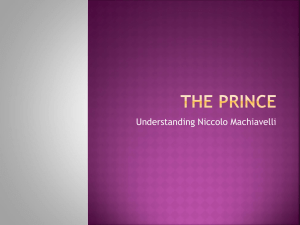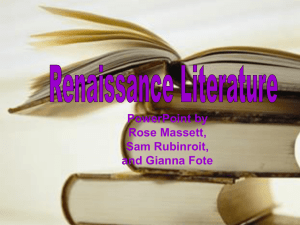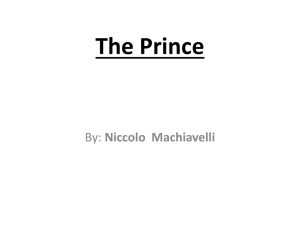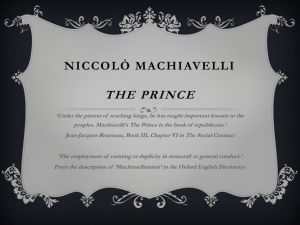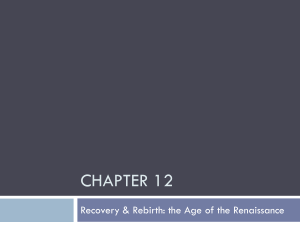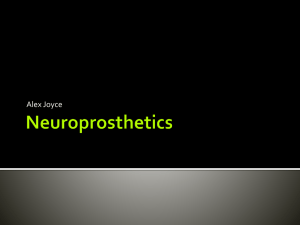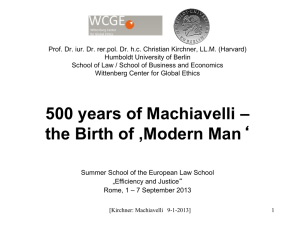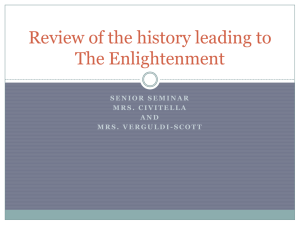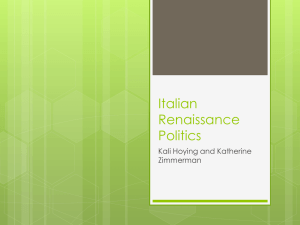Machiavelli PowerPoint
advertisement
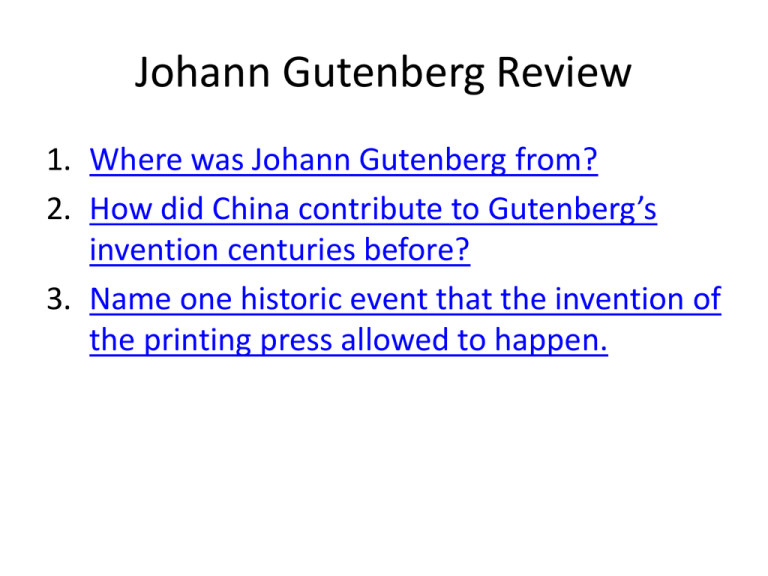
Johann Gutenberg Review 1. Where was Johann Gutenberg from? 2. How did China contribute to Gutenberg’s invention centuries before? 3. Name one historic event that the invention of the printing press allowed to happen. Germany • China had produced the first woodblock printing in the 200s and created moveable type print in the 1000s. • The invention of the modern printing press allowed for – the Reformation, – the Scientific Revolution, – the Age of Exploration – and the Enlightenment • to take place. 10-2-2013 • EQ: How did the work of Machiavelli influence how people viewed political power? • I can describe some of Machiavelli's political ideas from The Prince. • What qualities should a good leader have? #1 Renaissance Figures: Niccolò Machiavelli “It is better to be feared than loved.” : #2 Renaissance Figures: Johann Gutenberg Don Raph Mike The Renaissance was a Movement in Europe in the 1400s that was a rebirth of classic Greek and Roman culture like art, literature, architecture and ideas. Leo http://www.teacherspayteachers.com/Product/Gutenberg-thePrinting-Press-Visual-textual-engaging-12-slide-PowerPoint679439 #3 Renaissance A rebirth of art Figures: Johann Gutenberg A rebirth of architecture Roman statue of Augustus Roman columns A rebirth of literature Roman historian Tacitus A rebirth of ideas Roman writer Cato Europeans had a ‘rebirth’ or renewed interest in art, architecture, literature and ideas, much like the Greeks and Romans before the Dark Ages http://www.teacherspayteachers.com/Product/Gutenberg-thePrinting-Press-Visual-textual-engaging-12-slide-PowerPoint679439 #4 Renaissance Figures: Niccolò Machiavelli Machiavelli was one of several famous Italian Renaissance figures. Although most of these men were known for their visual arts (paintings and sculptures), Machiavelli was famous for his writings. Donatello – Leonardo – Raphael Machiavelli – Marco Polo - Michelangelo #5 Renaissance Figures: Niccolò Machiavelli According to goodreads.com, Machiavelli’s The Prince is in the top-five best best books from or about the Renaissance: 5) The Civilization of the Renaissance in Italy (Jacob Burckhardt) 4) The Prince (Niccolo Machavelli) 3) The House of Medici: Its Rise and Fall (Christopher Hibbert) 2) Brunelleschi’s Dome: How a Renaissance Genius Reinvented Architecture (Ross King) 1) The Life of Elizabeth I (Alison Weir) #6 Renaissance Figures: Niccolò Machiavelli Niccolò Machiavelli (1469-1527) was an Italian writer and politician during the Renaissance. He spent most of his adult life in Florence and served as a government official there. #7 Renaissance Figures: Niccolò Machiavelli Many historians credit Machiavelli as the founder of political science because of how his work and writings shaped modern politics. Political Science is the study of governments and politics. #8 Renaissance Figures: Niccolò Machiavelli Machiavelli wrote many different types of literature including historical books, comedies, songs and poems. But his most famous work was a guidebook for rulers to gain and keep power, called The Prince. https://www.youtube.com/watch?v=s25kX24j250 #9 Renaissance Figures: Niccolò Machiavelli The Prince had an immediate impact in shaping the behavior of leaders. Certain wealthy and powerful families often controlled parts of Italy. Many members of these families even became popes. One of the most notorious, powerful and wealthy Italian families of the time was the Medici family. Four Popes from the Medici Family: Leo X Clement VII Pius IV Leo XI Cesare Borgia: ruthless leader and son of Pope Alexander VI #10 Renaissance Figures: Niccolò Machiavelli The Medici family had controlled Florence for over half a century before a republic was established. Machiavelli served as a politician in that republic. And although his book The Prince discussed how to gain and keep power, the Medici family eventually took over once again and Machiavelli no longer served in government. Four Popes from the Medici Family: Leo X Clement VII Pius IV Leo XI Cesare Borgia: ruthless leader and son of Pope Alexander VI #11 Renaissance Figures: Niccolò Machiavelli The Prince was so monumental that words like “Machiavellianism” and “Machiavellian” are still commonly used today to describe any sort of authority figure who tries to manipulate people under their influence. #12 Renaissance Figures: Niccolò Machiavelli Machiavelli's The Prince was like a Renaissance guide book with advice for rulers. In the book, Machiavelli made suggestions such as ‘don’t hire mercenaries’, ‘don’t borrow troops from your allies’ and ‘make people think you are merciful’. #13 Renaissance Figures: Niccolò Machiavelli Excerpt from Machiavelli's The Prince: “A controversy has arisen about this: whether it is better to be loved than feared, or vice versa. My view is that it is desirable to be both loved and feared; but it is difficult to achieve both and, if one of them has to be lacking, it is much safer to be feared than loved…For love is sustained by a bond of gratitude which, because men are excessively self-interested, is broken whenever they see a chance to benefit themselves. But fear is sustained by a dread of punishment that is always effective.” 1) According to the Prince, what does Machiavelli believe to be the key ingredients for effective leadership? 2) Select a quotation from the excerpt that supports your answer to question number one. Renaissance Figures: Niccolò Machiavelli Excerpt from Machiavelli's The Prince: 1) A controversy has arisen about this: whether it is better to be loved than feared, or vice versa. 2) My view is that it is desirable to be both loved and feared; but... 3) …it is difficult to achieve both and, if one of them has to be lacking, it is much safer to be feared than loved… 4) For love is sustained by a bond of gratitude which, because men are excessively self-interested, is broken whenever they see a chance to benefit themselves. 5) But fear is sustained by a dread of punishment that is always effective Translate and shorten each of the five parts of the paragraph into your own words…

